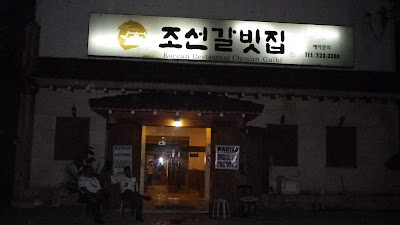" You don't need a silver fork to eat good food, an ordinary chopsticks will do."
Trying a foreign dish is knowing the culture of that country. Korean influence has reach Philippines many years ago has been contributing to our multi-cultural aspect. K-pop, Korean fashion, Korean products, Korean movies and dramas and Korean cuisine has been a part of Filipinos venture exchanging culture.
Last February, I tried this famous Korean restaurant near IT Park, Lahug. Chosun Galbi is well-known for its tasty Korean dishes. My friends and I didn't want to lose the chance not to taste of these Korean dishes and also have a touch of Korean culture.

Chosun Galbi near IT Park
Since we went there a little after 12 midnight, Chosun Galbi was not so crowded. Again this is my first time experience in a Korean restaurant like my few post in my blog. The waitresses were kind enough to teach us the basics of Korean cuisine and introducing us to their specialty dishes. Being a fanatic of Korean dramas, I already got the basics of the food names and utensils. We tend to compare those Korean drama scenes with what we were dealing at the restaurant. Now, let the food battle begin.
Korean Dishes 101 (Our Orders)
- Samgyeopsal 삼겹살 - It consists of thick, fatty slices of pork belly meat. The meat, usually neither marinated nor seasoned on a drill at the diner's table. Usually diners grill the meat themselves and eat directly from a grill. It is most commonly dipped in sesame seed oil mixed with salt and pepper.
- Galbisal 갈비살 - Unseasoned beef meat cooked on a grill.
- Bibimbap 비빔밥 - The word literally means "mixed rice". It is served as a bowl of warm white rice topped with namul (sauteed and seasoned vegetables) and gochujang (chili pepper paste), soy sauce, or doenjang (salty soybean paste). A raw or fried egg and sliced meat (usually beef) are common additions. The hot dish is stirred together thoroughly just before eating.
- Soju 소주 - Korea's most popular alcoholic beverage containing ethanol and water.
Side dishes :
- Kimchi 김치 - is a traditional fermented Korean side dish made of vegetables with a variety of seasonings.
- Sukjunamul 숙주나물 (mung bean sprout) - The sprouts were cooked only a minute in boiling water before seasoning.
- Gochu 고추 (fresh green peppers) - 5-6 inches in length and half in diameter with medium thick skin are mildly hot and well-flavored.
- Sigeumchi namul 시금치나물 (Spinach side dish) - Lightly blanched spinach dressed with spring onions, garlic and sesame seeds.
- Ssam 쌈 - refers to various leaf vegetables which are used to wrap a piece of bite-size meat along with dwenjang (fermented soybean paster), gochujang (chili pepper paste) or ssamjang (mixed paste of gochujang dwenjang and other seasonings) and some rice into bundle. The vegetables used for wrapping can vary but primarily consists of fresh red leaf lettuce, sesame leaves or parboiled cabbage.
- Soondubu jjigae 순두부찌개 - Korean tofu soup

Sigeumchi namul and Bibimbap with Soju


Samgyeopsal in action.

Ssam on the roll to our mouths.
This Korean dishes made our mouths water. It was a sumptuous meal to remember. Chosun Galbi made our first Korean cuisine experience worth repeating. Though the food price was above average it was still worth it. Why not spent a little more than usual if it pays great experience.
Food Prices:
Samgyeopsal - 250 php
Galbisal - 700 php
Bibimbap - 300 php
Soju - 200 php
Plain rice - 50 php
Mango Juice - 50 php
We may have spent over than usual but when you go Dutch with your friends it will pay you less. Nevertheless, our first Korean cuisine experiences wont match we the money we paid.

No comments:
Post a Comment